2014 FIAT 500L LIVING Warning lights
[x] Cancel search: Warning lightsPage 135 of 420
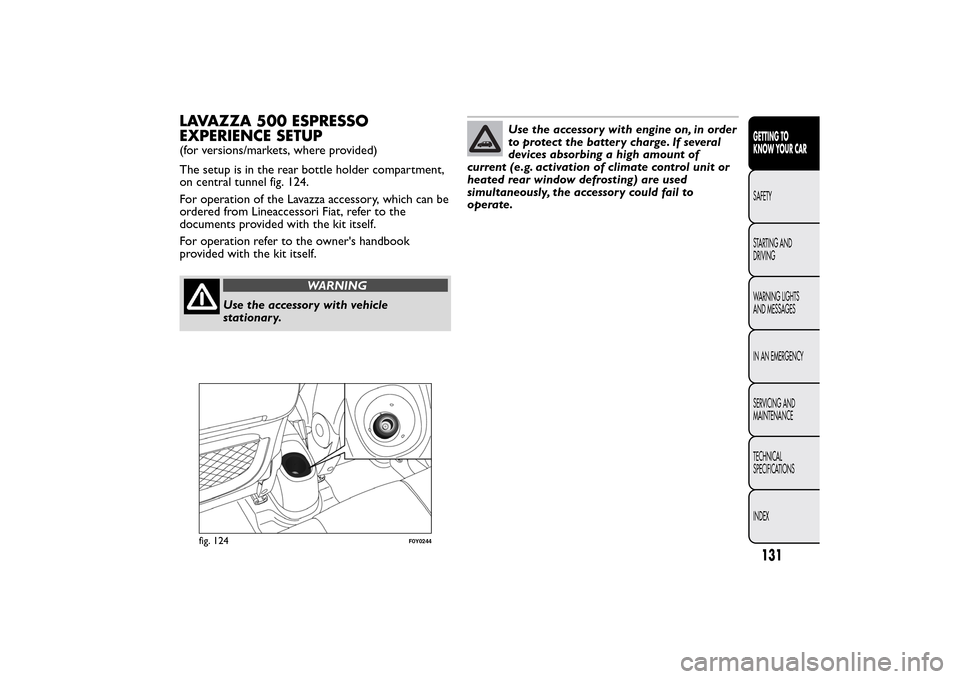
LAVAZZA 500 ESPRESSO
EXPERIENCE SETUP(for versions/markets, where provided)
The setup is in the rear bottle holder compartment,
on central tunnel fig. 124.
For operation of the Lavazza accessory, which can be
ordered from Lineaccessori Fiat, refer to the
documents provided with the kit itself.
For operation refer to the owner's handbook
provided with the kit itself.
WARNING
Use the accessor y with vehicle
stationar y.
Use the accessor y with engine on, in order
to protect the batter y charge. If several
devices absorbing a high amount of
current (e.g. activation of climate control unit or
heated rear window defrosting) are used
simultaneously, the accessor y could fail to
operate.
fig. 124
F0Y0244
131GETTING TO
KNOW YOUR CARSAFETY
STARTING AND
DRIVING
WARNING LIGHTS
AND MESSAGES
IN AN EMERGENCY
SERVICING AND
MAINTENANCE
TECHNICAL
SPECIFICATIONS
INDEX
Page 136 of 420
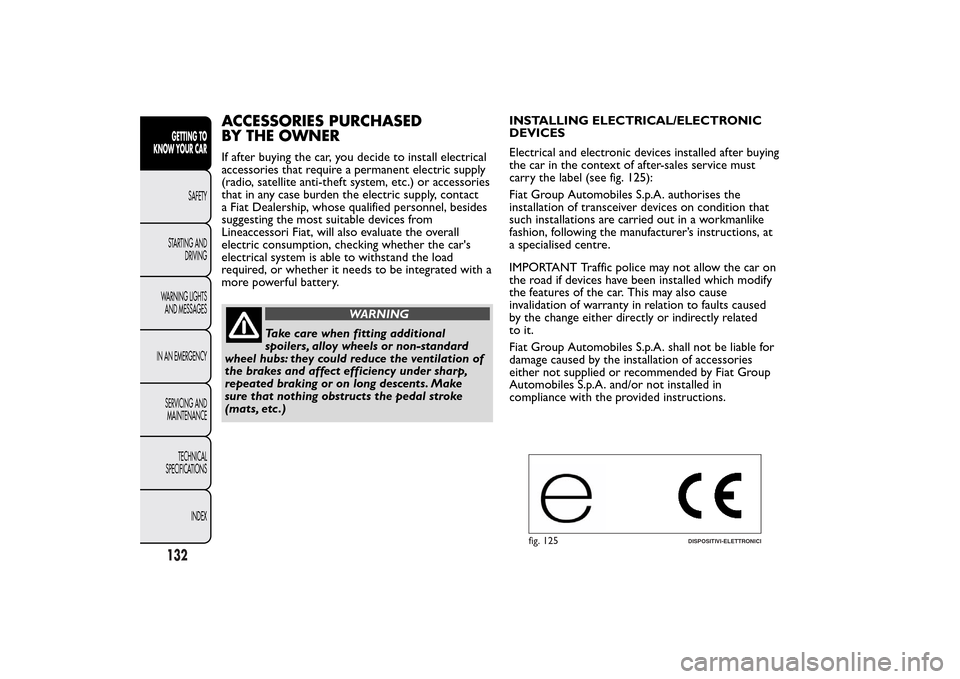
ACCESSORIES PURCHASED
BY THE OWNERIf after buying the car, you decide to install electrical
accessories that require a permanent electric supply
(radio, satellite anti-theft system, etc.) or accessories
that in any case burden the electric supply, contact
a Fiat Dealership, whose qualified personnel, besides
suggesting the most suitable devices from
Lineaccessori Fiat, will also evaluate the overall
electric consumption, checking whether the car's
electrical system is able to withstand the load
required, or whether it needs to be integrated with a
more powerful battery.
WARNING
Take care when fitting additional
spoilers, alloy wheels or non-standard
wheel hubs: they could reduce the ventilation of
the brakes and affect efficiency under sharp,
repeated braking or on long descents. Make
sure that nothing obstructs the pedal stroke
(mats, etc .)INSTALLING ELECTRICAL/ELECTRONIC
DEVICES
Electrical and electronic devices installed after buying
the car in the context of after-sales service must
carry the label (see fig. 125):
Fiat Group Automobiles S.p.A. authorises the
installation of transceiver devices on condition that
such installations are carried out in a workmanlike
fashion, following the manufacturer’s instructions, at
a specialised centre.
IMPORTANT Traffic police may not allow the car on
the road if devices have been installed which modify
the features of the car. This may also cause
invalidation of warranty in relation to faults caused
by the change either directly or indirectly related
to it.
Fiat Group Automobiles S.p.A. shall not be liable for
damage caused by the installation of accessories
either not supplied or recommended by Fiat Group
Automobiles S.p.A. and/or not installed in
compliance with the provided instructions.
fig. 125
DISPOSITIVI-ELETTRONICI
132GETTING TO
KNOW YOUR CAR
SAFETY
STARTING AND
DRIVING
WARNING LIGHTS
AND MESSAGES
IN AN EMERGENCY
SERVICING AND
MAINTENANCE
TECHNICAL
SPECIFICATIONS
INDEX
Page 137 of 420
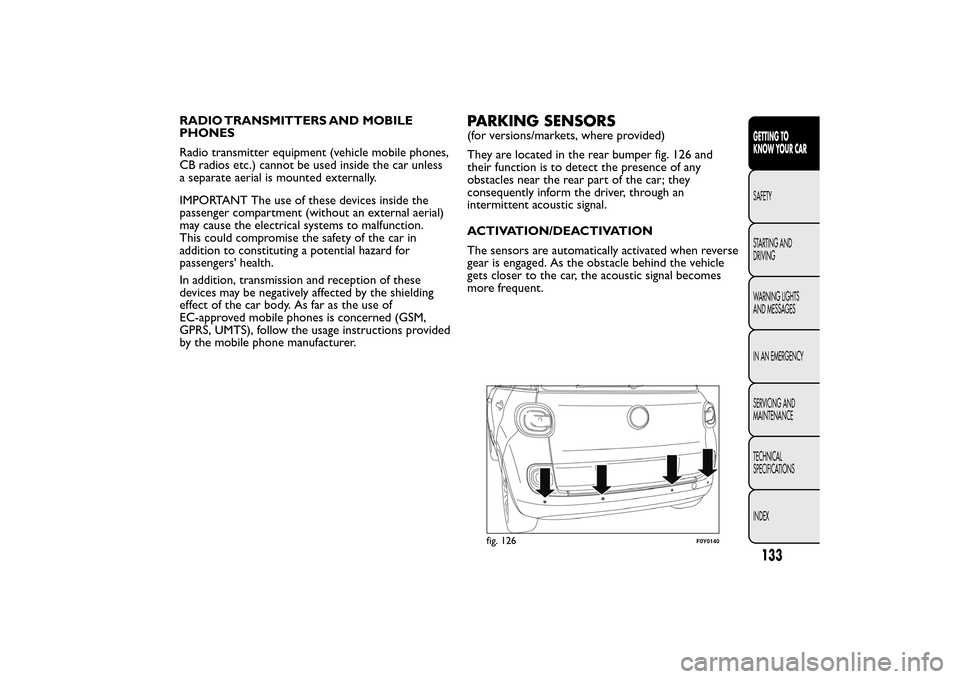
RADIO TRANSMITTERS AND MOBILE
PHONES
Radio transmitter equipment (vehicle mobile phones,
CB radios etc.) cannot be used inside the car unless
a separate aerial is mounted externally.
IMPORTANT The use of these devices inside the
passenger compartment (without an external aerial)
may cause the electrical systems to malfunction.
This could compromise the safety of the car in
addition to constituting a potential hazard for
passengers' health.
In addition, transmission and reception of these
devices may be negatively affected by the shielding
effect of the car body. As far as the use of
EC-approved mobile phones is concerned (GSM,
GPRS, UMTS), follow the usage instructions provided
by the mobile phone manufacturer.
PARKING SENSORS(for versions/markets, where provided)
They are located in the rear bumper fig. 126 and
their function is to detect the presence of any
obstacles near the rear part of the car; they
consequently inform the driver, through an
intermittent acoustic signal.
ACTIVATION/DEACTIVATION
The sensors are automatically activated when reverse
gear is engaged. As the obstacle behind the vehicle
gets closer to the car, the acoustic signal becomes
more frequent.
fig. 126
F0Y0140
133GETTING TO
KNOW YOUR CARSAFETY
STARTING AND
DRIVING
WARNING LIGHTS
AND MESSAGES
IN AN EMERGENCY
SERVICING AND
MAINTENANCE
TECHNICAL
SPECIFICATIONS
INDEX
Page 138 of 420
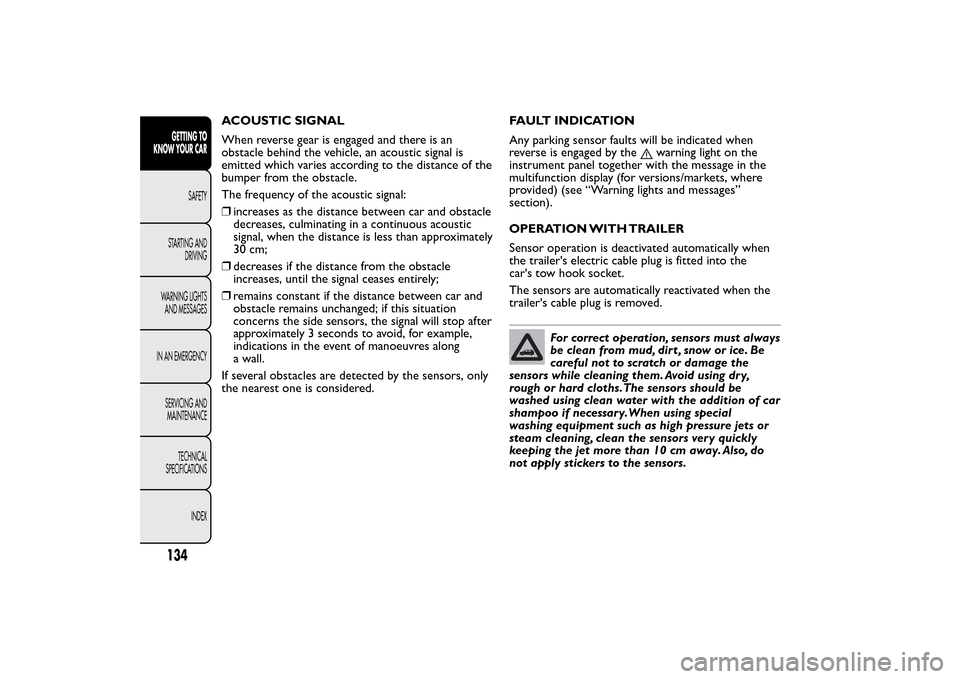
ACOUSTIC SIGNAL
When reverse gear is engaged and there is an
obstacle behind the vehicle, an acoustic signal is
emitted which varies according to the distance of the
bumper from the obstacle.
The frequency of the acoustic signal:
❒increases as the distance between car and obstacle
decreases, culminating in a continuous acoustic
signal, when the distance is less than approximately
30 cm;
❒decreases if the distance from the obstacle
increases, until the signal ceases entirely;
❒remains constant if the distance between car and
obstacle remains unchanged; if this situation
concerns the side sensors, the signal will stop after
approximately 3 seconds to avoid, for example,
indications in the event of manoeuvres along
a wall.
If several obstacles are detected by the sensors, only
the nearest one is considered.FAULT INDICATION
Any parking sensor faults will be indicated when
reverse is engaged by the
warning light on the
instrument panel together with the message in the
multifunction display (for versions/markets, where
provided) (see “Warning lights and messages”
section).
OPERATION WITH TRAILER
Sensor operation is deactivated automatically when
the trailer's electric cable plug is fitted into the
car's tow hook socket.
The sensors are automatically reactivated when the
trailer's cable plug is removed.
For correct operation, sensors must always
be clean from mud, dirt , snow or ice. Be
careful not to scratch or damage the
sensors while cleaning them. Avoid using dry,
rough or hard cloths.The sensors should be
washed using clean water with the addition of car
shampoo if necessary.When using special
washing equipment such as high pressure jets or
steam cleaning, clean the sensors very quickly
keeping the jet more than 10 cm away. Also, do
not apply stickers to the sensors.
134GETTING TO
KNOW YOUR CAR
SAFETY
STARTING AND
DRIVING
WARNING LIGHTS
AND MESSAGES
IN AN EMERGENCY
SERVICING AND
MAINTENANCE
TECHNICAL
SPECIFICATIONS
INDEX
Page 139 of 420
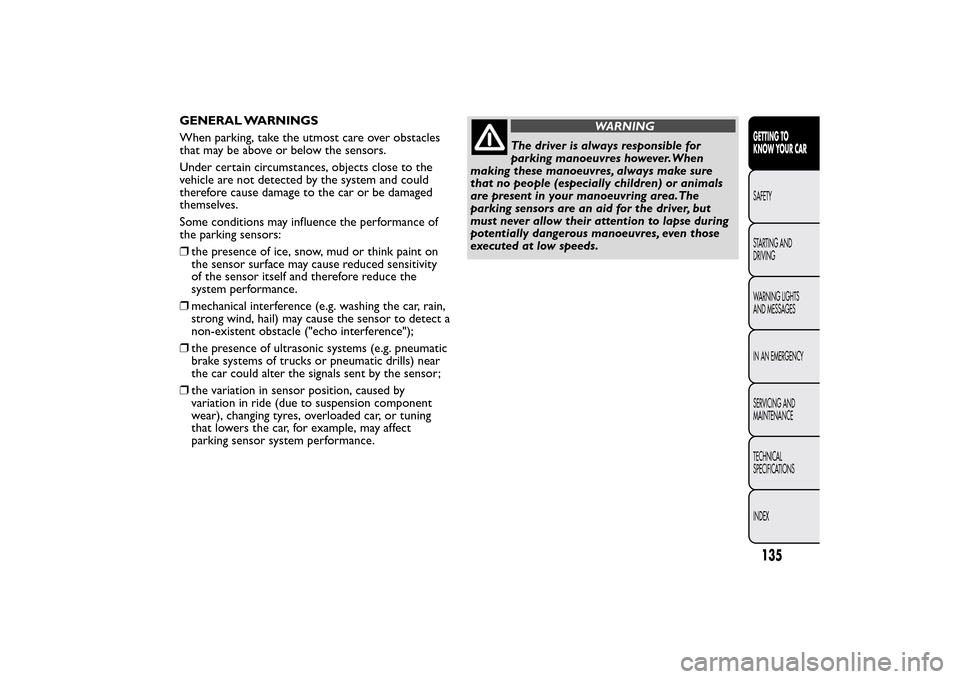
GENERAL WARNINGS
When parking, take the utmost care over obstacles
that may be above or below the sensors.
Under certain circumstances, objects close to the
vehicle are not detected by the system and could
therefore cause damage to the car or be damaged
themselves.
Some conditions may influence the performance of
the parking sensors:
❒the presence of ice, snow, mud or think paint on
the sensor surface may cause reduced sensitivity
of the sensor itself and therefore reduce the
system performance.
❒mechanical interference (e.g. washing the car, rain,
strong wind, hail) may cause the sensor to detect a
non-existent obstacle ("echo interference");
❒the presence of ultrasonic systems (e.g. pneumatic
brake systems of trucks or pneumatic drills) near
the car could alter the signals sent by the sensor;
❒the variation in sensor position, caused by
variation in ride (due to suspension component
wear), changing tyres, overloaded car, or tuning
that lowers the car, for example, may affect
parking sensor system performance.
WARNING
The driver is always responsible for
parking manoeuvres however.When
making these manoeuvres, always make sure
that no people (especially children) or animals
are present in your manoeuvring area.The
parking sensors are an aid for the driver, but
must never allow their attention to lapse during
potentially dangerous manoeuvres, even those
executed at low speeds.
135GETTING TO
KNOW YOUR CARSAFETY
STARTING AND
DRIVING
WARNING LIGHTS
AND MESSAGES
IN AN EMERGENCY
SERVICING AND
MAINTENANCE
TECHNICAL
SPECIFICATIONS
INDEX
Page 140 of 420
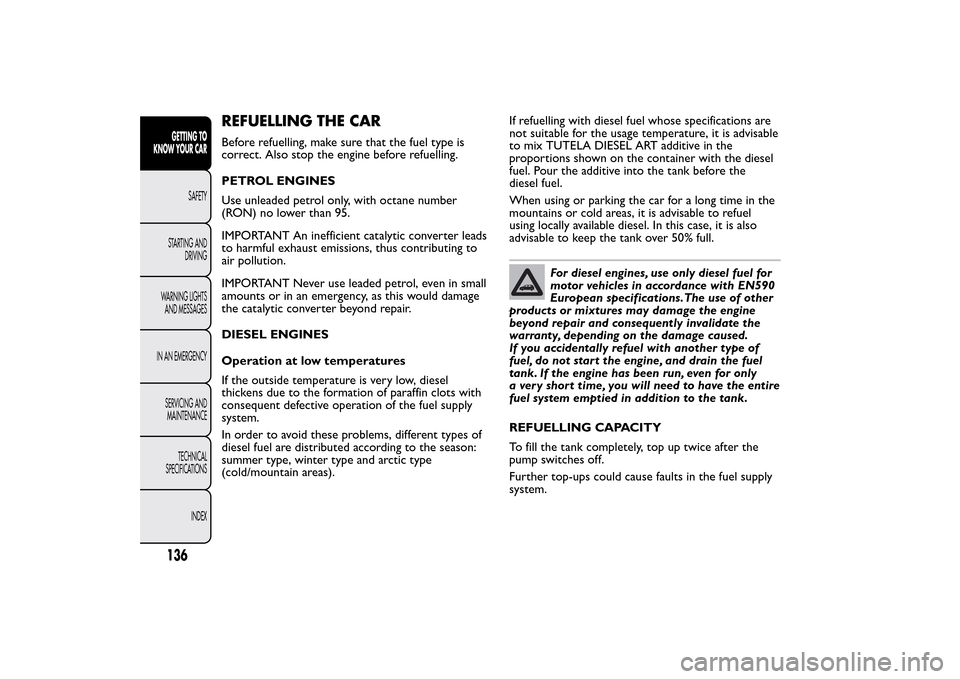
REFUELLING THE CARBefore refuelling, make sure that the fuel type is
correct. Also stop the engine before refuelling.
PETROL ENGINES
Use unleaded petrol only, with octane number
(RON) no lower than 95.
IMPORTANT An inefficient catalytic converter leads
to harmful exhaust emissions, thus contributing to
air pollution.
IMPORTANT Never use leaded petrol, even in small
amounts or in an emergency, as this would damage
the catalytic converter beyond repair.
DIESEL ENGINES
Operation at low temperatures
If the outside temperature is very low, diesel
thickens due to the formation of paraffin clots with
consequent defective operation of the fuel supply
system.
In order to avoid these problems, different types of
diesel fuel are distributed according to the season:
summer type, winter type and arctic type
(cold/mountain areas).If refuelling with diesel fuel whose specifications are
not suitable for the usage temperature, it is advisable
to mix TUTELA DIESEL ART additive in the
proportions shown on the container with the diesel
fuel. Pour the additive into the tank before the
diesel fuel.
When using or parking the car for a long time in the
mountains or cold areas, it is advisable to refuel
using locally available diesel. In this case, it is also
advisable to keep the tank over 50% full.
For diesel engines, use only diesel fuel for
motor vehicles in accordance with EN590
European specifications.The use of other
products or mixtures may damage the engine
beyond repair and consequently invalidate the
warranty, depending on the damage caused.
If you accidentally refuel with another type of
fuel, do not start the engine, and drain the fuel
tank. If the engine has been run, even for only
a ver y shor t time, you will need to have the entire
fuel system emptied in addition to the tank.
REFUELLING CAPACITY
To fill the tank completely, top up twice after the
pump switches off.
Further top-ups could cause faults in the fuel supply
system.
136GETTING TO
KNOW YOUR CAR
SAFETY
STARTING AND
DRIVING
WARNING LIGHTS
AND MESSAGES
IN AN EMERGENCY
SERVICING AND
MAINTENANCE
TECHNICAL
SPECIFICATIONS
INDEX
Page 141 of 420
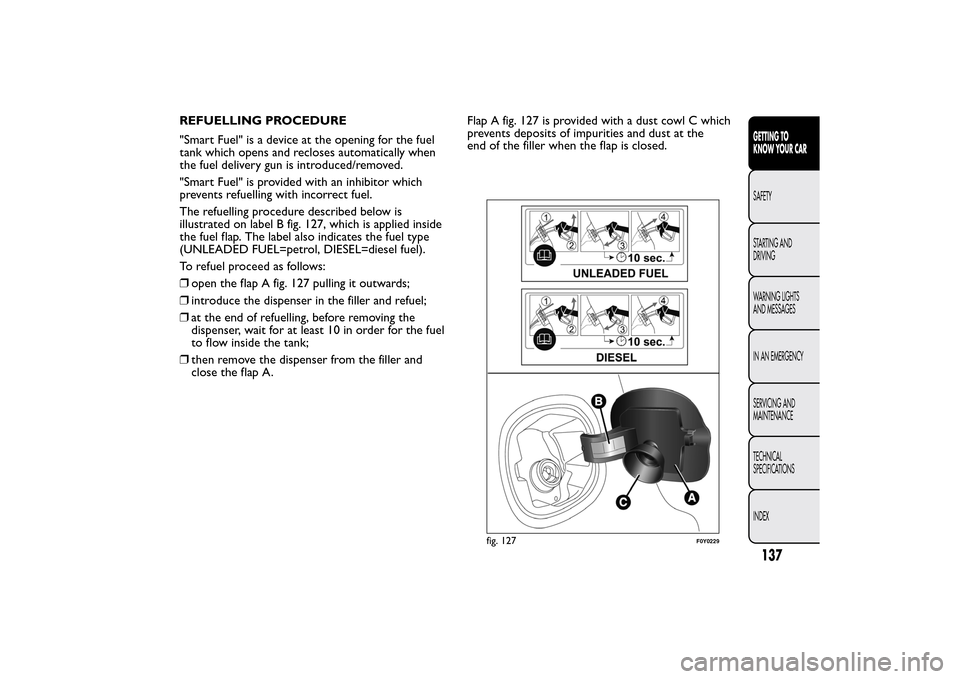
REFUELLING PROCEDURE
"Smart Fuel" is a device at the opening for the fuel
tank which opens and recloses automatically when
the fuel delivery gun is introduced/removed.
"Smart Fuel" is provided with an inhibitor which
prevents refuelling with incorrect fuel.
The refuelling procedure described below is
illustrated on label B fig. 127, which is applied inside
the fuel flap. The label also indicates the fuel type
(UNLEADED FUEL=petrol, DIESEL=diesel fuel).
To refuel proceed as follows:
❒open the flap A fig. 127 pulling it outwards;
❒introduce the dispenser in the filler and refuel;
❒at the end of refuelling, before removing the
dispenser, wait for at least 10 in order for the fuel
to flow inside the tank;
❒then remove the dispenser from the filler and
close the flap A.Flap A fig. 127 is provided with a dust cowl C which
prevents deposits of impurities and dust at the
end of the filler when the flap is closed.
fig. 127
F0Y0229
137GETTING TO
KNOW YOUR CARSAFETY
STARTING AND
DRIVING
WARNING LIGHTS
AND MESSAGES
IN AN EMERGENCY
SERVICING AND
MAINTENANCE
TECHNICAL
SPECIFICATIONS
INDEX
Page 142 of 420
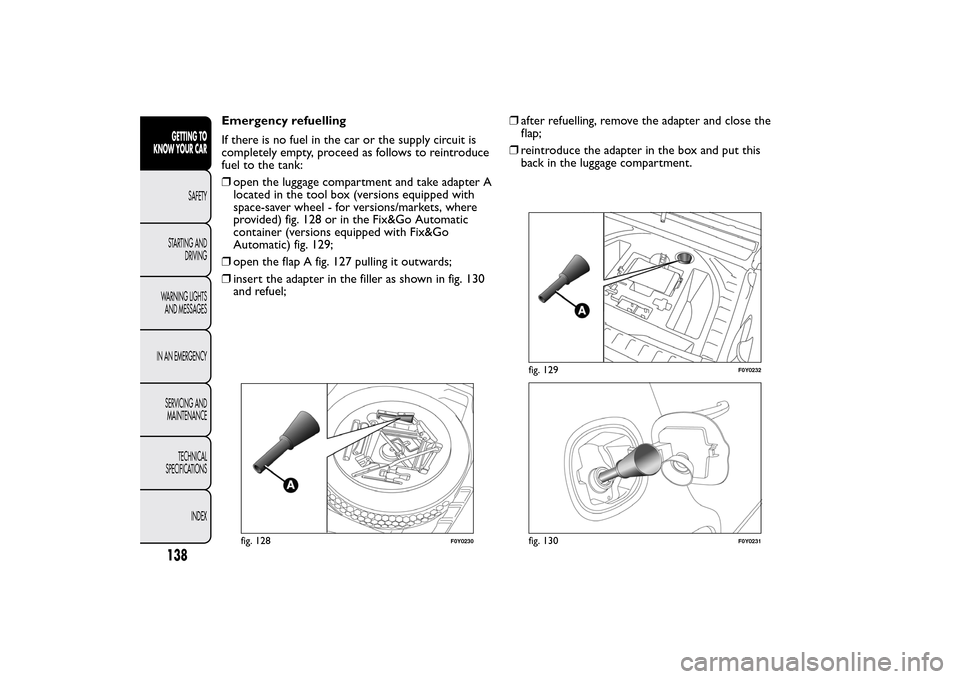
Emergency refuelling
If there is no fuel in the car or the supply circuit is
completely empty, proceed as follows to reintroduce
fuel to the tank:
❒open the luggage compartment and take adapter A
located in the tool box (versions equipped with
space-saver wheel - for versions/markets, where
provided) fig. 128 or in the Fix&Go Automatic
container (versions equipped with Fix&Go
Automatic) fig. 129;
❒open the flap A fig. 127 pulling it outwards;
❒insert the adapter in the filler as shown in fig. 130
and refuel;❒after refuelling, remove the adapter and close the
flap;
❒reintroduce the adapter in the box and put this
back in the luggage compartment.
fig. 128
F0Y0230
fig. 129
F0Y0232
fig. 130
F0Y0231
138GETTING TO
KNOW YOUR CAR
SAFETY
STARTING AND
DRIVING
WARNING LIGHTS
AND MESSAGES
IN AN EMERGENCY
SERVICING AND
MAINTENANCE
TECHNICAL
SPECIFICATIONS
INDEX